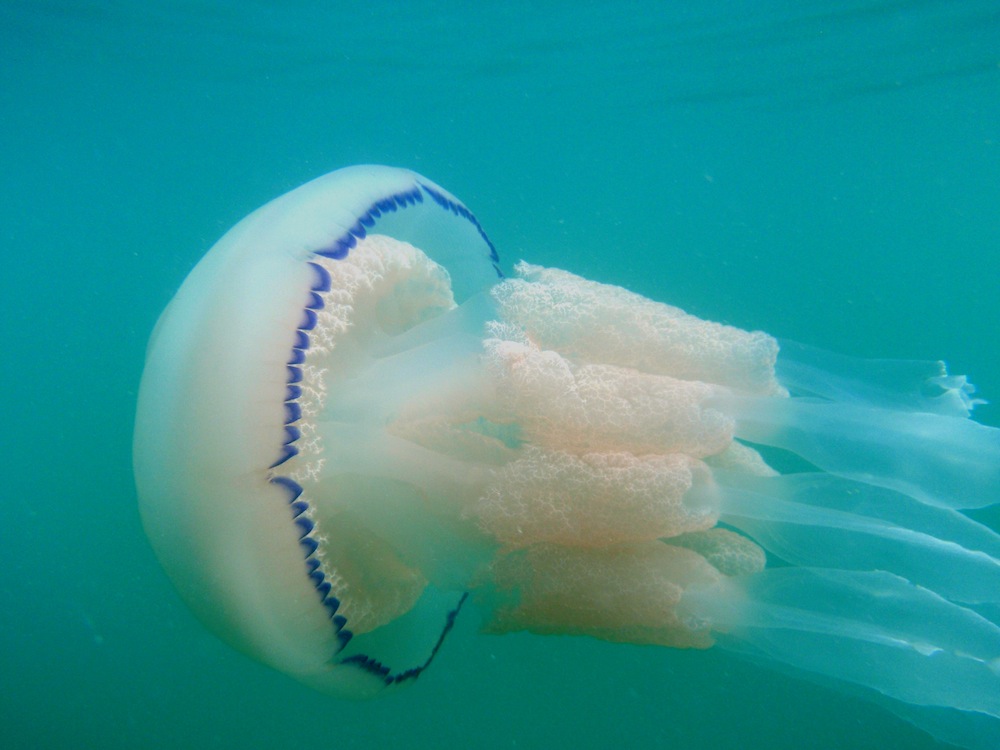Lowly Jellyfish Uses High-Tech Strategy to Find Food

The barrel jellyfish, isn't just the largest jelly found in the waters around the United Kingdom, it's also one of the animal kingdom's most strategic searchers, according to a new study.
To locate the best possible meal in the vast waters of its marine habitat, the barrel jellyfish (Rhizostoma octopus) uses a strategy most commonly associated with the world's fastest supercomputers — an approach known as fast simulated annealing.
For mathematicians, fast simulated annealing is an algorithm, implemented by a supercomputer, which can find optimal solutions to complex problems in a relatively short amount of time. For jellyfish, fast simulated annealing is a highly evolved search strategy categorized by a series of predictable movements that bring the jelly closer and closer to large numbers of plankton, its preferred prey. [Album: Amazing Photos of Jellyfish Swarms]
This complex search strategy has never been observed before in nature, according to study lead author Andy Reynolds, a scientist at Rothamsted Research, an agricultural research center in the U.K.
Yet, other mathematical patterns of movement have been widely observed in the natural world, Reynolds said. The most common of these patterns, the "Lévy walk," is a less complex version of the barrel jelly's approach.
"A Lévy walk is [a] random walk in which frequently occurring small steps are interspersed with more rarely occurring longer steps, which in turn are interspersed with even rarer, even longer steps and so on," Reynolds told Live Science in an email. (The Lévy walk was named after French mathematician Paul Lévy, who was noted for his work in the theory of probability.)
While this may sound like a fairly complex way of searching for something, Reynolds said it's similar to the way you might search for your lost car keys in the living room sofa and then, not finding them there, head over to the closet to check your coat pocket.
Get the world’s most fascinating discoveries delivered straight to your inbox.
"This hierarchical nested pattern is highly effective when searching because once an area has been intensively surveyed, the searcher is relocated to another area and then begins a new bout of intensive searching," Reynolds said. [Marine Marvels: Spectacular Photos of Sea Creatures]
Some of the species that have been observed using Lévy walks to locate their meals include sharks, penguins, honeybees, ants, turtles and even human hunter-gatherers.
But among these many species, the barrel jelly stands out because, in addition to exhibiting this Lévy walk pattern, it also engages several search methods that others species don't seem to use.
Move like a jellyfish
One of the barrel jelly's search-optimizing behaviors, often referred to as a "bounce," occurs when the jellyfish starts out in one depth of water and then makes a long glide either upwards or downwards to a different depth of water. If it doesn't find a meal in the new location, the jellyfish will "bounce" again to return to its original position.
Some scientists believe that the jelly's tendency to bounce around in the water may actually hinder its ability to search for food, but according to Reynolds, these unusual animals have had it right all along.
The jellyfish, which will sometimes repeat its pattern of bounces dozens of times a day, uses this strategy to slowly home in on the highest concentrations of plankton, Reynolds explained.
The behavior therefore makes the barrel jelly even more efficient than other marine animals, such as penguins and sharks, that only use Lévy walks to search for prey, Reynolds said.
Is bouncing better?
If the barrel jelly's unusual way of searching for food really is the best way to do it, then why aren't other marine species using the same strategy?
The answer has to do with diet, Reynolds said. The barrel jellyfish benefits from spending long periods of time searching for concentrations of prey because it needs to eat a lot of plankton before it is satisfied, Reynolds said. This is different from sharks and penguins, which Reynolds said can survive by eating the occasional fish.
"A Lévy search is highly effective in finding the next meal, when any meal will do. Fast simulated annealing, on the other hand, takes the forager to the best possible meal," Reynolds said. "This is what makes jellyfish special — they are very discerning diners, unlike bony fish, penguins, turtles and sharks, which are just looking for any meal."
This high level of discernment is also what draws certain mathematicians and engineers to the strategy of fast simulated annealing for supercomputing, Reynolds said.
Based on mathematical and computer models, Reynolds' study found that like barrel jellyfish, mathematicians tend to implement this strategy only when they're looking for the best possible solution to a problem, not a variety of potential solutions.
The new study was published online today (Aug. 5) in the Journal of the Royal Society Interface.
Follow Elizabeth Palermo on Twitter @techEpalermo, Facebook or Google+. Follow Live Science @livescience. We're also on Facebook & Google+. Original article on Live Science.


